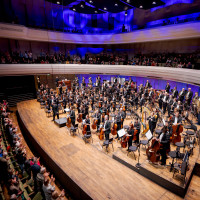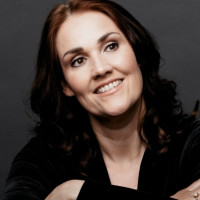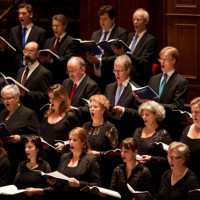Program Booklet
Fauré's Requiem
Friday , Oct. 17
20:15
hour until approximately 10:30 p.m.
A special and varied concert in which we welcome the Netherlands Radio Choir for Fauré's heavenly Requiem.
📳
Please put your phone on silent and dim the screen so as not to disturb others during the concert. Taking photos is allowed during applause.
Programme
Prior to this concert there will be a Starter at 7:30 pm. A lively and informal program with live performances by our own musicians and interviews with soloists and conductors. The Starter is free of charge and will take place on the grandstand steps opposite the cloakroom.
Hendrik Andriessen (1892-1981)
Miroirde Peine (1923, orchestrated in 1933)
Agonie au jardin
Flagellation
Couronnement d'épines
Portement de Croix
Crucifixion
Ludwig van Beethoven (1770-1827)
Symphony No. 4 in B-flat, op. 60 (1806)
Adagio - Allegro vivace
Adagio
Allegro vivace
Allegro ma non troppo
At intermission we will serve a free drink.
Gabriel Fauré (1845-1924)
Messede Requiem in d, op. 48 (1887-1890; orchestral version 1899-1900)
Introït et Kyrie
Offertoire
Sanctus
Pie Jesu
Agnus Dei
Libera me
In paradisum
What are you going to listen to?
One of Europe's finest choirs with one of the most beautiful requiems ever composed - the Netherlands Radio Choir returns to The Hague for Gabriel Fauré's Requiem. This mass opens the heart, with waves of poignancy juxtaposed against gentle consolation. Not a farewell, but a tribute to life itself: a requiem for those who live and go on.
Mystical simplicity
But this concert begins with Miroir de Peine by Dutch composer Hendrik Andriessen, a subdued song cycle about Christ's Passion seen through the eyes of Mary. Mary's heart breaks during the Last of her son Jesus, whose agony she must watch helplessly. Thus Andriessen, who was no fan of ultra-emotional expressionism, arrived at a melancholy and subdued meditation on the Passion and a hymn to true maternal love. The song cycle Miroir de Peine, initially written for soprano and organ, was created in 1923 on texts by the poet Henri Ghéon. Andriessen deliberately chose an archaic song cycle in which mystical simplicity, universal love and religious devotion set the tone. Thus arose five intimate 'prayers' which - also in the arrangement for orchestra that Andriessen made of it ten years later - serenely but powerfully express the vain cry for help and the longing for intimacy.
A slender Greek virgin
The most substantial part of Beethoven's income came from composition commissions awarded to him by aristocratic admirers. Thus, in the summer of 1806, Beethoven went to the Hungarian palace of Count Franz Brunsvik, where he spent a delightful time in the presence of the count's three sisters. Even before the summer was over, Beethoven left for the summer residence of Prince Karl Lichnowsky in Silesia. Lichnowsky introduced Beethoven to a neighbor, Count Franz Oppersdorff, a wealthy aristocrat who attached such importance to music that he did not hire any staff member who did not play an instrument. A great admirer of Beethoven, he immediately had a performance of his Second Symphony arranged and on that occasion commissioned Beethoven to compose two new symphonies. Beethoven put aside his Symphony in c (the Fifth) and began work on a new one, which he completed at Lichnowsky's palace as late as the autumn of 1806. However, it was not Oppersdorff's orchestra that played the premiere of the Fourth Symphony. This Fourth was first played at a Viennese concert in March 1807, at the palace of Prince Lobkowitz, one of Beethoven's other patrons.
In Beethoven's oeuvre, the Fourth is, along with the Eighth, the least played symphony. Perhaps because, with its classical cut to Mozart and Haydn, it so contrasts with its surrounding symphonies, the powerful Eroica and the popular Fifth. "Just as No. 8 lives in the valley between the colossal No. 9 and the almost equally colossal No. 7, so No. 4 is equally overshadowed," noted encyclopedist Sir George Grove. Robert Schumann best characterized the Fourth: "A slender Greek maiden between two Norwegian giants."
A lullaby of death
It is not clear why Gabriel Fauré began a requiem in 1887. Was it because his father had died two years earlier or because his mother was dying? He himself would say, "I didn't compose it for anything, just for pleasure." He did want to write something different than usual, as he detested the dramatic and bombastic death masses of Berlioz and Verdi, for example. But above all, Fauré had a very different vision of death than could be heard in these requiems. "A happy release, a pursuit of happiness above rather than a painful experience," was how Fauré viewed dying. And he expressed this in the hopeful and subdued sounds of his Requiem: "My Requiem is gentle in temperament, like myself," he said of it. "It does not express the fear of death. Someone even called it a lullaby of death." Deliberately, Fauré chose not to include a "Dies irae" in his Requiem; a thundering section on Judgment Day did not fit with his vision of death. However, he did set the "Pie Jesu," with a moving soprano solo and with emphasis on the word "requiem," or "rest. It became one of the most beautiful and famous movements and, of course, sounded at Fauré's own funeral in 1924.
Prefer it on paper? Download a condensed printable version of this program.
Biographies

Residentie Orkest The Hague
.jpg/96786dfa51d2a7bcccd996181050b8e9.jpg)
Tianyi Lu

Judith van Wanroij

Raoul Steffani

Netherlands Radio Choir
Want to read along with the lyrics of "Miroir de Peine" and the "Requiem"? Download them here!
Fun Fact
Rebellious Fauré
Fauré's first job was not a success. As organist of the Basilica Saint-Sauveur in Rennes, he regularly slipped out during Mass to smoke a cigarette. On one occasion he even appeared on Sunday morning in his clothes from that night's ball, which did not go down well with the priest.

RO QUIZ
Where was the public premiere of Beethoven's Fourth Symphony?-
Musikverein
Good answer: Burgtheater
The first (private) performance of Beethoven's Fourth Symphony took place in March 1807 at Lobkowitz Palace, with the world premieres of the Overture "Coriolan" and Piano Concerto No. 4 at the same private concert. The general public could not learn about Beethoven's Fourth until April 1808, at the Burgtheater. This theater stood on Michaelerplatz, against the imperial Hofburg, until 1888.
-
Theater an der Wien
Good answer: Burgtheater
The first (private) performance of Beethoven's Fourth Symphony took place in March 1807 at Lobkowitz Palace, with the world premieres of the Overture "Coriolan" and Piano Concerto No. 4 at the same private concert. The general public could not learn about Beethoven's Fourth until April 1808, at the Burgtheater. This theater stood on Michaelerplatz, against the imperial Hofburg, until 1888.
-
Burgtheater
Good answer: Burgtheater
The first (private) performance of Beethoven's Fourth Symphony took place in March 1807 at Lobkowitz Palace, with the world premieres of the Overture "Coriolan" and Piano Concerto No. 4 at the same private concert. The general public could not learn about Beethoven's Fourth until April 1808, at the Burgtheater. This theater stood on Michaelerplatz, against the imperial Hofburg, until 1888.

Good answer: Burgtheater
The first (private) performance of Beethoven's Fourth Symphony took place in March 1807 at Lobkowitz Palace, with the world premieres of the Overture "Coriolan" and Piano Concerto No. 4 at the same private concert. The general public could not learn about Beethoven's Fourth until April 1808, at the Burgtheater. This theater stood on Michaelerplatz, against the imperial Hofburg, until 1888.
Today in the orchestra
Help The Hague get music!
Support us and help reach and connect all residents of The Hague with our music.


View all program booklets
Be considerate of your neighbors and turn down your screen brightness.


